Is this the track ready car you have been saving up for?
Last week, BMW’s M GmbH department unleashed this beauty into the market and the enthusiasts went to town sharing these pictures and details of this track ready car.
‘Dream are for free’ car lovers are already comparing its statistics with rivals from AMG and RS but not everyone will have the money or the ability to have one in their garage (especially on this side of the world). The closest rival in our books is actually the Porsche Cayman GT4 and if both were in our garage we will be a happy driver.
Best part of this M2 CS is its manual gearbox (yes there is seven-speed dual-clutch auto on the options list for posers who can’t really drive) and standard analogue instruments. No technology filled interruptions to divert the driver’s attention away from the performance entrusted to the chassis.
Then there is the question of size. Here size matters, the nimbler and smaller the better. Unlike its siblings, the M3 CS and M5 who have grown and have added heft, this M2 CS is compact and lighter and thus more agile.
The press release says that this is BMW’s M GmbH department first ever foray into the premium compact segment with its prestigious and overtly sporty portfolio of limited-run special-edition models. Prices for this BMW M2 CS start at €95,000 which is about RM435,000 before local taxes and delivery costs.
BMW’s M GmbH department plans to build and sell just 2,200 units for global consumption so best you get your order in quick or else wait for a used gray import to come in one year from now.
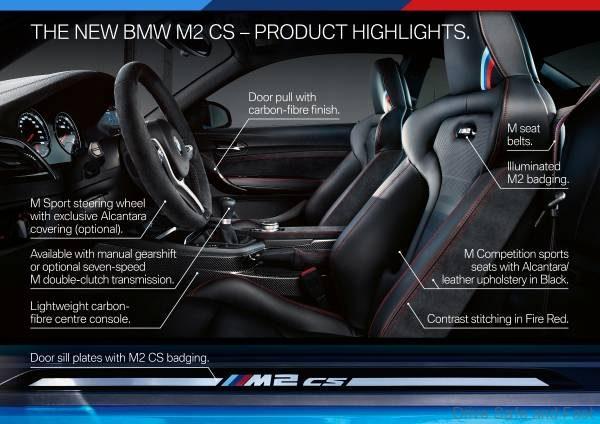


PRESS RELEASE: This exclusive BMW M2 CS is positioned one rung up the performance ladder from the BMW M2 Competition and will build on the success already achieved by the BMW M3 CS and BMW M4 CS models.
This Immensely capable car also serves as a basis for the BMW M2 CS Racing model, BMW M Motorsport’s new entry point to amateur racing and the new Clubsport segment from the 2020 season.
The BMW M2 CS has an even sharper look about it than the BMW M2 Competition and blends outstanding track performance with unrestricted everyday usability to create a four-seater sports car of exceptional appeal. The BMW M2 CS sets new, class-leading standards for acceleration, handling dynamics, precision and agility, making it the perfect choice for fans of high-calibre high-performance cars. The new gateway into the world of BMW M GmbH products will also stir the emotions of a younger target audience.
BMW M GmbH has used an array of carbon fibre-reinforced plastic (CFRP) components to give the limited-run special-edition BMW M2 CS an extremely sporty appearance that vividly conveys its exceptional agility and dynamism before a wheel has turned. The output of the twin-turbocharged straight-six engine has increased to 331 kW (450 hp) – up 29 kW (40 hp) on the BMW M2 Competition – while the Adaptive M suspension hitherto reserved for the M4 models and the Michelin Cup tyres transfer this immense power to track and road alike to optimum effect. Commensurate levels of stopping power are provided by the standard M Sport brakes with red-painted callipers or optional M Carbon ceramic brakes.

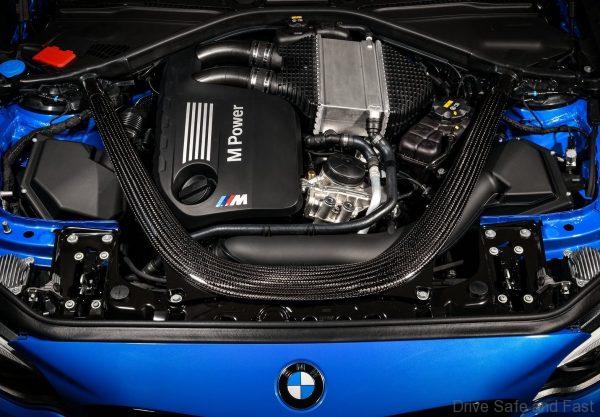

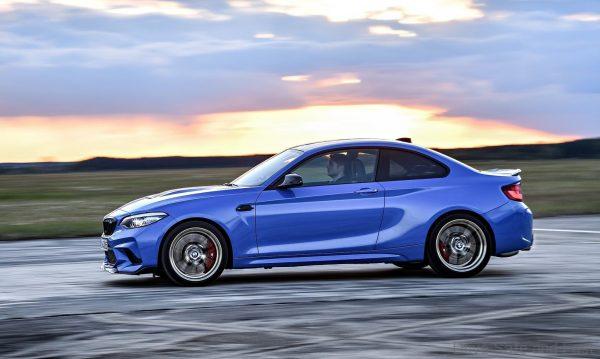
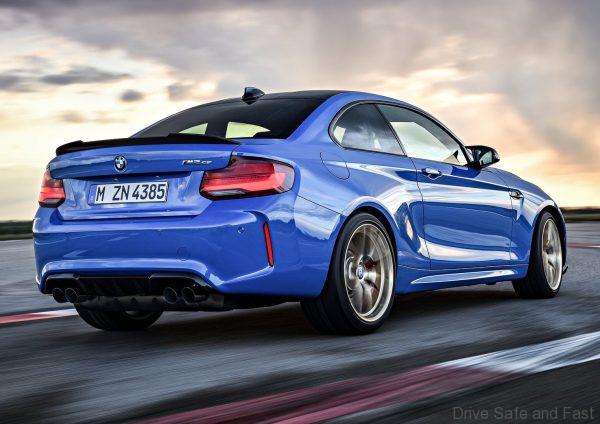
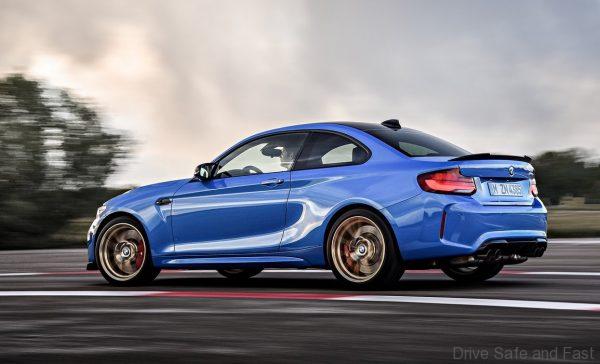
Eye-catching design
The BMW M2 CS delivers instant visual confirmation of its sporting credentials, its stylistic modifications clearly distinguishing it from the BMW M2 Competition. The design team at BMW M GmbH focused in particular on the use of carbon fibre, a material that stirs the emotions and creates a strong link to racing cars through the intelligent lightweight design and exceptional body strength it promotes.
New bonnet and roof made from carbon fibre
A new CFRP bonnet, created specially for the BMW M2 CS, complements the BMW M2 premiere of a roof also made entirely from carbon fibre. The bonnet of the BMW M2 Competition has been modified to include an eye-catching central air vent in High-gloss Black towards its leading edge. The new design increases the car’s downforce over the front wheels and also aids engine cooling. The bonnet’s weight, meanwhile, has been halved. The new roof, with its sandwich design, makes the body more rigid and appears to have been cut from the same mould as the rest of the car; no trim strips are needed, meaning no visible joins either. This has the additional effect of enhancing acoustics, both inside and outside the car. And dispensing with the customary roof bows and insulation also saves weight. Together with the lighter bonnet, this serves to lower the vehicle’s centre of gravity, resulting in even better driving dynamics.




Front splitter, Gurney and rear diffuser optimise aerodynamics
The new front splitter located south of the front apron, the Gurney spoiler lip on the boot lid and the rear diffuser are all made from exposed carbon fibre, giving them a striking appearance. Inspired by aerodynamic components used in racing cars, this trio of add-ons gives the M2 CS greater downforce and channels the air flowing around and underneath the body to optimise aerodynamics. The carbon-fibre caps of the streamlined M twin-stalk exterior mirrors round off the CFRP elements in the M2 CS. Bringing the car’s design to a stunning conclusion is the redesigned dual-branch exhaust system with its quartet of stainless-steel tailpipes, M logo and M2 CS badge. The Misano Blue metallic paint finish is exclusive to the new BMW M2 CS.

Driving dynamics
The new BMW M2 CS extends a family lineage established by the BMW M3 CS and BMW M4 CS. It has been engineered for the express purpose of delivering scintillating track performance, but without falling short of the mark in everyday road use. The BMW M2 Competition’s top-class agility, driving feel, handling stability, steering precision and controllability at the limit have been elevated another notch to make the BMW M2 CS a sports car of indisputable authenticity.
Adaptive M suspension and M Sport brakes fitted as standard
Underpinning the sensational driving dynamics of the BMW M2 CS are the standard-fitted Adaptive M suspension and M Sport brakes designed with the help of the motor-racing know-how. Formerly the preserve of the M4 models, Adaptive M suspension gives drivers the choice of Comfort, Sport and Sport+ modes, each of which alters the damper settings. Comfort mode offers excellent ride comfort in everyday urban driving, Sport lends itself to powering along country roads, and drivers taking their BMW M2 CS out on a track will want to select Sport+; the firmest chassis setup minimises body movement and maximises dynamic performance.
The Electric Power Steering with M-specific characteristics – which controls power assistance electronically according to the car’s speed and the Drivelogic settings selected – allows the driver to adapt the level of power assistance to suit their personal preferences and is also adjusted in line with the three suspension modes. The M Sport brakes also benefit from the motor racing experience of BMW M GmbH.
Compared with the M compound brakes featured on the BMW M2 Competition, the brake discs are larger (front: diameter 400 mm, rear: diameter 380 mm) and the brake callipers – painted in a bold red colour – have also been upgraded (front: six-piston fixed callipers, rear: four-piston fixed callipers). This highly capable system delivers exceptional braking performance with outstanding stopping power in all conditions, plus excellent fade resistance and thermal stability. The BMW M2 CS is also available with the option of M Carbon ceramic brakes with six-piston callipers at the front and four-piston units at the rear. These are lighter, can withstand the sorts of extreme loads exerted during track use and are longer lasting too.
Stiff front-end structure enhances steering precision
The CFRP high-precision strut brace employed in the M2 CS has already seen action in the BMW M2 Competition. This single-piece carbon-fibre component weighs a mere 1.5 kg and combines with the tower-to-bulkhead strut to give the car’s front end a high level of stiffness. This, in turn, has a positive impact on turn-in response and steering precision. The front and rear axles have a lightweight aluminium construction and transfer forces laterally by means of ball joints with zero play for high-precision wheel location. Specially designed elastomeric bearings in the torque arms result in direct longitudinal transmission of the chassis forces, which also ensures the desired level of ride comfort.
All of the five-link rear axle’s control arms and wheel carriers are made from forged aluminium. The rear-axle subframe, with its lightweight steel construction, also has a rigid bolted connection to the body without any flexible rubber elements. Typically used in racing cars, this type of mounting further improves wheel location and directional stability.

Active M Differential and specially tuned DSC
The electronics of the DSC (Dynamic Stability Control) system govern the car’s handling with fingertip sensitivity, generate excellent grip when driving in wet or slippery conditions and prevent an abrupt breakaway of traction middrift. The DSC is aided in its task by the Active M Differential, an electronically controlled multi-plate locking mechanism that enhances traction and handling stability with unbeatable precision and speed. The locking effect can be varied between 0 and 100 per cent, depending on the driving situation, and factors in steering angle, accelerator pedal position, brake pressure, engine torque, wheel speeds and yaw rate.
By analysing the situation in this way, the control unit can detect an imminent loss of traction on one side and calculate the ideal degree of lock, which is then applied using an electric motor. It takes just 150 milliseconds to generate maximum locking torque of 2,500 Newton metres (1,843 lb-ft). This serves to prevent wheel spin even in extreme conditions on slippery surfaces or when one rear wheel has far less grip than the other.
The Active M Differential can even intervene proactively in certain situations. When pulling away on slippery road surfaces, for example, a certain percentage of lock is engaged before a wheel can start to spin, ensuring that both wheels build up identical amounts of slip at the same time. And in high-speed corners, the levels of lateral acceleration and drive torque dictate the degree of the lock required to stop an unloaded inside wheel from turning too fast. The differential’s permanent and continuously variable control also results in sharper agility, elimination of understeer at corner entry and superior directional stability during braking and load changes.
M Dynamic Mode (MDM) is a DSC sub-function that can be selected as required to allow a greater degree of wheel slip. This can be beneficial in certain situations, such as high-speed track driving. It pushes back the intervention points for the DSC system’s various stabilising measures, giving drivers extra leeway to explore the car’s dynamic limits.
Increasing wheel slip enhances traction, which then helps to propel the car down the road with extra assurance. More significant oversteer and understeer are possible, as are moderate, controlled drifts. However, drivers can still depend on the array of DSC driving safety aids to intervene in critical situations.
19-inch wheels with Cup tyres
The BMW M2 CS rides on 19-inch Y-spoke forged wheels in a High-gloss Black finish. Here again, the M GmbH engineers have applied the principles of systematic lightweight design. As a result, the 9J x 19 wheels at the front weigh just 9 kilograms, while the 10J x 19 items at the rear add less than 10 kilograms. This keeps unsprung masses low and is another factor in the extraordinarily dynamic potency of the M2 CS. The wheels can also be specified in an optional matt gold shade.
The front wheels are shod with 245/35 ZR 19 Michelin Pilot Sport Cup 2 tyres that have been specially matched to the M2 CS and offer the ultimate in lateral control, directional stability, steering feel and steering precision, while the 265/35 ZR 19 tyres at the rear optimise traction, lateral control and directional stability. Customers intending to use their M2 CS mainly for everyday driving can select the no-cost option of Michelin Pilot Super Sport tyres, which generate more grip on wet roads than the Cup items.
Engine
The twin-turbocharged six-cylinder in-line engine in the BMW M2 CS is derived from the unit fitted in the BMW M4 Competition Coupe and offers the best of both worlds. On the one hand, it has an extraordinary appetite for revs for a turbocharged engine, plus linear power build-up over a wide rpm band and a distinctive soundtrack. And M TwinPower Turbo technology keeps peak torque on tap across a wide engine speed range. But the engine will also put a smile on the driver’s face with its exemplary efficiency.
The straight-six generates maximum output of 331 kW (450 hp) at 6,250 rpm, 29 kW (40 hp) more than the BMW M2 Competition. Peak torque of 550 Newton metres (405 lb-ft) is on tap between 2,350 and 5,500 rpm. This enables the BMW M2 CS to race to 100 km/h (62 mph) from rest in just 4.0 seconds when equipped with the optional seven-speed M doubleclutch transmission (M DCT).
The same sprint takes 4.2 seconds with the six-speed manual gearbox. The top speed of the special-edition model, which comes complete with the M Driver’s Package, is an electronically governed 280 km/h (174 mph). Manual models achieve combined fuel consumption figures of 10.4 – 10.2 l/100 km [27.2 – 27.7 mpg imp) and combined CO2 emissions of 238 – 233 g/km. Cars fitted with the M DCT transmission burn just 9.6 – 9.4 l/100 km [29.4 – 30.1 mpg imp) on the combined cycle with CO2 emissions of 219 – 214 g/km. The petrol particulate filter fitted in the BMW M2 CS in the relevant EU countries further reduces particulate emissions.
Instantaneous response thanks to M TwinPower Turbo technology
The package of BMW TwinPower Turbo technology comprises two fastresponse mono-scroll turbochargers, High Precision Injection direct petrol injection, VALVETRONIC variable valve timing and Double-VANOS fully variable camshaft timing. The variable valve and camshaft timing combine to enable continuous adjustment of intake valve lift as required. This allows the engine to build up its power to optimum effect while also responding at lightning speed to the drivers’ inputs.
At the same time, fuel consumption and exhaust emissions are reduced. The six-cylinder engine’s crankcase is remarkably rigid thanks to its closed-deck construction, paving the way for higher cylinder pressures and improved power output. Cylinder walls with a wire-arc sprayed coating instead of liners help to keep the weight of the engine down.
Racing car experience to the fore
The level of performance offered by cars such as the BMW M2 CS places specific demands on engine oil supply during track use. This is an area where BMW M GmbH’s many years of motor racing experience come into play. The oil sump, for instance, has an additional cover to restrict the lubricant’s movement under the high lateral forces exerted during sharp changes in direction. There is also an extra oil scavenge pump and a sophisticated oil return system near the turbocharger to keep the oil circuit functioning smoothly under extreme acceleration and braking. This ensures a reliable supply of oil for every engine component under all circumstances – from everyday road use through to maximum attack on the track.
The BMW M2 CS makes allowance for the greater quantities of cooling air required by the engine with measures such a CFRP bonnet featuring design modifications over the BMW M2 Competition’s. Incorporating an air vent, for example, helps to dissipate hot air more effectively. The BMW M2 CS has retained its sibling’s large kidney grille and large air intakes in the front apron to optimise the flow of air through the car’s front end.
The track-tested cooling system originates from the BMW M4 with Competition Package and comprises a central radiator plus two radiators at the sides, along with an additional engine oil cooler. Models specified with the optional seven-speed M DCT also benefit from a separate transmission oil cooler. This sophisticated system ensures that optimum operating temperatures are maintained at all times, not only in everyday road use and on short urban journeys, but also during outings on the track.
Dual-branch exhaust system with two electrically controlled flaps
Offering even greater aesthetic and aural appeal than in the BMW M2 Competition, the exhaust system has a dual-branch design and concludes in a familiar quartet of tailpipes, each bearing the M logo. Two electrically controlled flaps ensure the BMW M2 CS emits a sound worthy of a BMW M model. The M Engine Dynamics Control function with direct selection buttons in the centre console allows drivers to vary the engine note further through their driving mode selection.
Choice of two transmissions
The BMW M2 CS is the first CS model from BMW to be fitted as standard with a six-speed manual gearbox, thereby catering to the often-expressed penchant of the M2’s target clientele for a good stickshift. Standout characteristics include its compact construction and low weight, while carbon friction linings for smoother shifting also feature. Shift comfort is further improved by the gearbox’s engagement speed control, which automatically blips the throttle when changing down and lowers the engine revs when changing up. This also gives the car extra stability when pushed hard on the track. Engagement speed control is deactivated when DSC is switched off.
Customers can also specify the optional seven-speed M double-clutch transmission (M DCT) with Drivelogic. DCT consists of two sub-transmissions (each with its own clutch), allowing both extremely fast gear changes without any interruption in power flow and silky smooth shifting, depending on the selected setting. The gear changes can be performed either automatically or manually by the driver using the gearshift lever on the centre console or the shift paddles on the M leather steering wheel. In both automatic and manual modes, the Drivelogic function gives the driver the choice of three preconfigured settings: EFFICIENT, SPORT and SPORT+. In automatic mode these alter shift timing, shift speed and the automatic blip of the throttle on downshifts.
The manual mode settings only affect the speed of gear shifts, with the timing determined by the driver. The system is able to predict the driver’s next gear selection based on rev speed, accelerator pedal position, acceleration and the chosen setting, allowing it to engage the next gear before the shift paddle has even been operated. At this point, one clutch is simply disengaged and the other engaged to complete the gear change with lightning speed.
Interior appointments
The cabin of the BMW M2 CS blends an exclusive, authentic aesthetic with the sporty looks and feel of fine Alcantara and innovative lightweight design. Its centre console is made entirely of lightweight carbon fibre, producing a weight saving of more than 50 per cent over the standard car’s. CFRP has also been used for the door pulls and door panel trim.
On their way into the BMW M2 CS, drivers are welcomed by a door sill plate with M2 CS badging before settling into the same lightweight M Sport seat fitted in the BMW M4 CS – an ergonomic and stylistic masterpiece of its kind. The seat’s bucket-style design takes its inspiration directly from motor racing and guarantees optimum lateral support even when the driver is pushing the limits on the race track. The seat backrests are upholstered in Merino leather and Alcantara, their red contrast stitching also gracing the armrests, the centre console and the door and side panel trim. The front seats’ integral head restraints feature BMW M stripes, while the backrests sport CS badging. CSspecific red contrast stitching appears again on the Merino leather rear seats.
M Sport steering wheel with Alcantara covering and centre marker
The optional M Sport steering wheel with exclusive Alcantara covering injects another shot of authentic racing flair into the cabin. It has a red centre marker to make racing drivers feel at home, and offers unbeatable grip in all driving situations. The distinctive M2 CS badging in the instrument cluster can be clearly seen through the M Sport steering wheel. Fine Alcantara also adorns the centre-console armrest and an interior trim strip on the instrument panel. The trim strip’s large red CS logo clearly identifies this as the new rangetopping car in the BMW M2 line-up – one that cuts a dashing figure both on the track and in day-to-day road driving.